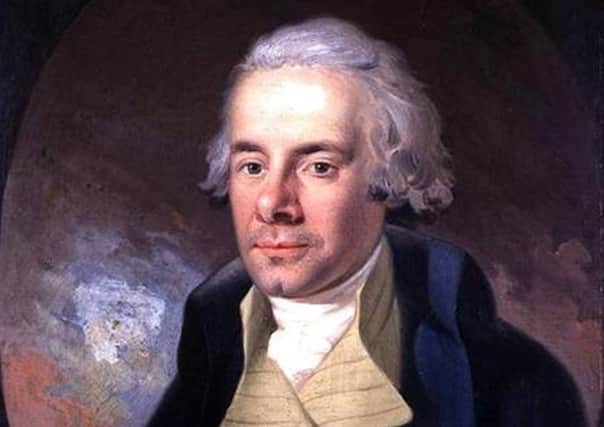Nostalgia: Champion of humane causes


However, “notwithstanding a few minor blemishes,” the first edition, which appeared in a single quarto volume, and sold for half a guinea, was so successful that reluctantly he agreed to a second “with considerable additions” in 1811.
This new version was inscribed by the author to “William Wilberforce, Esq., Member of Parliament for the County of York, as a memorial of long and disinterested attachment resulting from the purest regard for his private virtues, and the unsullied patriotism and exalted humanity of his public life...”
Advertisement
Hide AdAdvertisement
Hide AdThomas Hinderwell and William Wilberforce were old friends and allies. In 1806, the former had published an engraving “to commemorate Mr Wilberforce’s ardent exertions for the abolition of the African slave trade, and his election for the fifth time as a representative in Parliament for the county of York”.
Hinderwell himself was a local champion of numerous humane causes. From his seat in the Common Hall (Town Council), which he occupied for 40 years until his retirement at the age of 72 in 1816, he was one of Scarborough’s leading and admired philanthropists. After his death in 1825, Samuel Bottomley, the town’s Presbyterian minister, declared that every charitable cause “whether in feeding the hungry, clothing the naked, instructing the ignorant, visiting the afflicted, or saving the drowning”, owed its success to Hinderwell.
Scarborough’s first lifeboat, the second in England; the Amicable Society, which educated and clothed poor Anglican children; the Humane Society, which received, fed and accommodated shipwrecked sailors; both Trinity House and the Merchant Seamen’s Society, which gave homes to widows, orphans and “broken seafarers”; and the town’s Auxiliary Bible Society - were all indebted to him during his lifetime and in his legacy.
Hinderwell believed passionately in the enlightening power of the Christian message, its ability “to civilise and evangelise the world, by the universal diffusion of the pure word of God”. He had died before Parliament abolished slavery throughout most of the British empire in 1833, but he had the greatest satisfaction of witnessing the ban on the British trade in slaves, which took effect after 1807. It was Hinderwell’s conviction, still widely shared even today, that Wilberforce, a fellow Yorkshireman, had been chiefly responsible for passing the Act of 1807.
Advertisement
Hide AdAdvertisement
Hide AdWhat neither of them seem to have understood was that the end of the Atlantic trade in slaves from Africa to the British West Indies would make certain the eventual extinction of slavery itself. Given that most slaves were male and that debilitating labour in tropical plantations reduced their life expectancy, slavery could survive only by the constant import of new “raw material”. Life expectation of a plantation negro in the Caribbean averaged only nine years.
Even today, two centuries after these events, there remains much misunderstanding, in some cases deliberate concealment, of the facts concerning British slavery. Abolition of the transportation and abolition of the institution are often confused or conflated. Both Acts of 1807 and 1833 applied only to British subjects and to the British Caribbean islands and Cape Colony, but not to British Ceylon (Sri Lanka) and British India. Also, the Atlantic slave trade did not end abruptly after the Act of 1807, even though it had been mainly in British ships: Spain, Portugal and the American South continued it for decades into the future.
The motives of abolitionists, such as Hinderwell and Wilberforce, are often attributed entirely to their Christian consciences and it is true that many leaders of the campaign were Quakers, evangelical Anglicans and Dissenters. However, it is rarely appreciated that the economic system of British slavery in the West Indies was moribund long before 1833. There were frequent, bloody rebellions of plantation slaves: on Barbados in 1816, in Demerara (Guyana) in 1823, and on Jamaica in 1831-2. Hundreds of slaves were killed by British soldiers, died in prison, or on the gallows. These uprisings undoubtedly contributed to the demand for abolition.
Above all, it is not well known, that British slaves would never have been freed then if those who owned or invested in their forced labour had not been promised and paid generous “compensation” for their losses of “property”. In 1833, the British government gave £20 million pounds (300 billion today) to 47,000 British owners of 800,000 slaves. The money borrowed by the Treasury to finance this colossal gift was not fully repaid until 2015! How many living British taxpayers know that they have been contributing to this repayment of the national debt?
Advertisement
Hide AdAdvertisement
Hide AdAs for Wilberforce, his contribution to the abolition of the slave trade is still grossly exaggerated and misreported. Unlike Hinderwell, he was a bigoted Anglican who looked down on “Nonconformist Dissenters” and his inflated reputation rests mainly on the partisan biography and selected letters published after his death by his two sons, Samuel and Robert.
The principal founder in 1787 of the Society for the Abolition of the Slave Trade was William Clarkson (1760-1846), not Wilberforce. It was Clarkson who, between 1787 and 1794, wore himself out travelling thousands of miles collecting evidence against the cruelties of the trade and the pro-slavery lobby in Parliament and the country. And it was Clarkson who supplied Wilberforce with the information and argument he would use effectively in the Commons.
When reading Hinderwell and his long association with Wilberforce, I wonder whether the former was aware that the chief port of the island of Barbados was called Scarborough; that Barbados was the world’s first modern slave society, its economy based solely on sugar plantation slave labour; and Castle Howard, the house he loved so much, was built partly on the exploitation of slave labour.